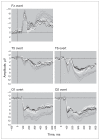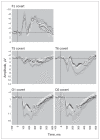Emotion brain alterations in anorexia nervosa: a candidate biological marker and implications for treatment
- PMID: 20598239
- PMCID: PMC2895157
- DOI: 10.1503/jpn.090073
Emotion brain alterations in anorexia nervosa: a candidate biological marker and implications for treatment
Abstract
Background: Identification of the biological markers of anorexia nervosa (AN) is crucial for the development of new treatments. We aimed to determine whether AN is associated with disturbances in the nonconscious neural processing of innate signals of emotion and whether these disturbances persist after weight gain.
Methods: In a retest design, 28 adolescent females with AN were tested at first ad not mission to hospital and again after they had gained weight. Matched healthy control participants were tested at the same times. We assessed emotion-elicited event-related potentials (ERPs) during overt and covert presentation of emotion expressions, scores on an emotion-identification behavioural task, and symptom measures. We performed between and within group analyses.
Results: Individuals with AN had a marked alteration in ERPs relative to healthy controls. Irrespective of the form of stimulus, early and late ERP componotnents were significantly reduced in AN patients at baseline (when underweight) and on retest (after weight gain), especially in the temporo-occipital regions, suggesting a persistent disruption of the early automatic appraisal of salient emotional signals.
Limitations: This study could have been improved with a longer standardized retest interval.
Conclusion: There is likely a core, generic disturbance in AN in the early "automatic" neural processing of emotion irrespective of weight or nutritional status. New innovative emotion-based psychologic or pharmacologic treatments targeting these nonconscious processes may prove beneficial.
Figures


Similar articles
-
Alterations in neural processing of emotional faces in adolescent anorexia nervosa patients - an event-related potential study.Biol Psychol. 2016 Sep;119:141-55. doi: 10.1016/j.biopsycho.2016.06.006. Epub 2016 Jun 23. Biol Psychol. 2016. PMID: 27345597
-
Assessment of brain function in adolescent anorexia nervosa before and after weight gain.J Clin Exp Neuropsychol. 1997 Feb;19(1):20-33. doi: 10.1080/01688639708403833. J Clin Exp Neuropsychol. 1997. PMID: 9071638
-
Superior facial emotion recognition in adolescents with anorexia nervosa - A replication study.Eur Eat Disord Rev. 2024 Sep;32(5):943-951. doi: 10.1002/erv.3103. Epub 2024 May 11. Eur Eat Disord Rev. 2024. PMID: 38733271
-
Anorexia nervosa: towards an integrative neuroscience model.Eur Eat Disord Rev. 2010 May;18(3):165-79. doi: 10.1002/erv.974. Eur Eat Disord Rev. 2010. PMID: 20443202 Review.
-
[Anorexia nervosa in the light of neurocognitive functioning: New theoretical and therapeutic perspectives].Encephale. 2014 Apr;40(2):160-7. doi: 10.1016/j.encep.2012.06.004. Epub 2013 Mar 28. Encephale. 2014. PMID: 23541918 Review. French.
Cited by
-
Higher reward value of starvation imagery in anorexia nervosa and association with the Val66Met BDNF polymorphism.Transl Psychiatry. 2016 Jun 7;6(6):e829. doi: 10.1038/tp.2016.98. Transl Psychiatry. 2016. PMID: 27271855 Free PMC article.
-
Anorexia Nervosa and a Lost Emotional Self: A Psychological Formulation of the Development, Maintenance, and Treatment of Anorexia Nervosa.Front Psychol. 2019 Mar 4;10:219. doi: 10.3389/fpsyg.2019.00219. eCollection 2019. Front Psychol. 2019. PMID: 30886593 Free PMC article.
-
The role of affect in the maintenance of anorexia nervosa: evidence from a naturalistic assessment of momentary behaviors and emotion.J Abnorm Psychol. 2013 Aug;122(3):709-19. doi: 10.1037/a0034010. J Abnorm Psychol. 2013. PMID: 24016011 Free PMC article.
-
Increased early motivational response to food in adolescent anorexia nervosa revealed by magnetoencephalography.Psychol Med. 2021 May 5;52(16):1-9. doi: 10.1017/S003329172100088X. Online ahead of print. Psychol Med. 2021. PMID: 33947486 Free PMC article.
-
A review of attention biases in women with eating disorders.Cogn Emot. 2013;27(5):820-38. doi: 10.1080/02699931.2012.749777. Epub 2012 Dec 11. Cogn Emot. 2013. PMID: 23228135 Free PMC article. Review.
References
-
- American Psychiatric Association. Diagnostic and statistical manual of mental disorders. 4th ed., text revised. Washington (DC): The Association; 2000.
-
- Steinhausen HC. The outcome of anorexia nervosa in the 20th century. Am J Psychiatry. 2002;159:1284–93. - PubMed
-
- Fairburn CG. Evidence-based treatment of anorexia nervosa. Int J Eat Disord. 2005;37:S26–30. - PubMed
-
- Bulik CM, Hebebrand J, Keski-Rahkonen A, et al. Genetic epidemiology, endophenotypes, and eating disorder classification. Int J Eat Disord. 2007;40:S52–60. - PubMed
Publication types
MeSH terms
Substances
LinkOut - more resources
Full Text Sources
Other Literature Sources
